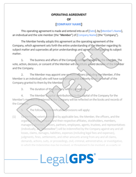Nonprofit Conflict of Interest Policy: A Comprehensive Guide
A conflict of interest policy is an important safeguard for any nonprofit organization. It helps protect the integrity of your organization by...
4 min read
Admin : Oct. 10, 2024
Bylaws are the backbone of your nonprofit. They provide the rules and structure needed to ensure smooth operation and effective governance. If you're starting a nonprofit, creating solid bylaws is one of the most important things you can do to set your organization up for success. In this guide, we’ll walk you through everything you need to know about writing bylaws that work.


Write Your Bylaws Today!
Legal GPS templates are drafted by top startup attorneys and are fully customizable🛠️.
Trusted by 1000+ businesses to close secure deals.
Nonprofit Bylaws are the internal rules that govern how your nonprofit will operate. Think of them as the owner's manual for your organization. They cover everything from the roles of directors and officers to how decisions are made and how conflicts are resolved. Here’s why they’re essential:
Legal Requirement: Most states require nonprofits to have bylaws.
Guidance for Operations: Bylaws outline procedures for board meetings, voting, and other key operations.
IRS Compliance: You’ll need to submit your bylaws when applying for federal tax-exempt status.
Without bylaws, your nonprofit can easily fall into disorganization, leading to governance issues and potentially jeopardizing your tax-exempt status.
Your bylaws should be comprehensive but easy to understand. Here are the key elements to include:
Start by clearly stating the name of your nonprofit and its purpose. This should align with the mission statement in your Articles of Incorporation.
Example: “The purpose of [Nonprofit Name] is to provide educational support and resources to underprivileged youth in [City/State].”
Decide whether your nonprofit will have members. Members can vote on major issues, like electing board members or dissolving the organization. If your nonprofit will not have members, then the board will make all major decisions.
Example: Most nonprofits are “board-driven” and don’t have voting members, which keeps decision-making straightforward.
Launch Your Nonprofit With Confidence
Number of Directors: Specify the minimum and maximum number of directors your board will have. Most states require at least three.
Terms: Define the length of terms for directors, such as two or three years, and whether they can serve consecutive terms.
Duties: Outline the responsibilities of the board, including setting policies, approving budgets, and overseeing the organization’s activities.
Election and Removal: Describe how new directors are elected and the process for removing a director if needed.
Example: “The Board of Directors shall consist of no fewer than three and no more than seven members, each serving a term of two years. Directors may serve up to three consecutive terms.”
Officers are typically responsible for the day-to-day operations of the nonprofit. Common officer roles include President, Secretary, and Treasurer. Your bylaws should specify:
Titles and Roles: Define each officer’s title and duties.
Election: Explain how officers are elected (usually by the board) and their term lengths.
Removal: Include the process for removing officers if necessary.
Example: “The Treasurer shall be responsible for overseeing the financial records, preparing the annual budget, and ensuring that proper financial procedures are followed.”
Board Meetings: Outline how often the board will meet (e.g., monthly, quarterly) and the procedures for calling meetings.
Annual Meetings: Specify whether your nonprofit will hold an annual meeting for members or stakeholders.
Notice Requirements: Detail how much notice must be given before a meeting and how it will be communicated (e.g., email, mail).
Example: “Regular board meetings shall be held quarterly, with at least ten days’ notice provided to each director via email.”
Quorum: Define the number of directors that must be present to make decisions (usually a majority).
Majority Vote: State how votes will be decided—typically by a simple majority.
Proxy Voting: Clarify whether directors can vote by proxy if they are unable to attend a meeting.
Example: “A quorum shall consist of a majority of the directors currently serving. Decisions shall be made by a majority vote of those present.”


Legal GPS Pro
Protect your business with our complete legal subscription service, designed by top startup attorneys.
To ensure transparency, include a conflict of interest policy. This policy should require board members to disclose any potential conflicts and recuse themselves from decisions where they have a personal interest.
Example: “Board members must disclose any potential conflicts of interest and refrain from voting on matters in which they have a financial or personal interest.”
If your nonprofit will have committees (e.g., Finance Committee, Fundraising Committee), describe their purpose and how members are appointed.
Example: “The Board may establish standing or ad hoc committees as needed. Committee members shall be appointed by the Board President.”
This section outlines whether the nonprofit will protect its directors and officers from personal liability for actions taken on behalf of the organization.
Example: “Directors and officers shall be indemnified by the corporation against any liability incurred in the performance of their duties to the fullest extent permitted by law.”
Your bylaws should include a procedure for making amendments. Typically, amendments require a vote by the board or the members.
Example: “These bylaws may be amended by a two-thirds vote of the Board of Directors at any regular or special meeting, provided that written notice of the proposed amendment is given to all board members at least 14 days in advance.”
Keep It Simple: Avoid overly complicated language. Your bylaws should be clear to everyone involved.
Be Thorough but Flexible: Include enough detail to provide guidance but allow for flexibility as your nonprofit evolves.
Consult an Attorney: While templates can be helpful, it’s wise to consult an attorney experienced in nonprofit law to ensure compliance with state and federal regulations.
Review Regularly: Your bylaws aren’t set in stone. Revisit them every few years to make sure they still meet your nonprofit’s needs.
Writing bylaws might seem intimidating, but they are crucial for establishing a strong foundation for your nonprofit. Well-crafted bylaws ensure that your organization runs smoothly, remains compliant with the law, and stays true to its mission. Take the time to draft bylaws that fit your organization’s needs, and don’t hesitate to seek professional advice to get them right.
Ready to start drafting? Use this guide as your roadmap, and soon you’ll have the structure in place to make your nonprofit’s mission a reality.

Write Your Bylaws Today!
Legal GPS templates are drafted by top startup attorneys and are fully customizable🛠️.
Trusted by 1000+ businesses to close secure deals.
The biggest question now is, "Do I need a business lawyer?” For most businesses and in most cases, you don't need a lawyer to start your business. Instead, many business owners rely on Legal GPS Pro to help with legal issues.
Legal GPS Pro is your All-In-One Legal Toolkit for Businesses. Developed by top startup attorneys, Pro gives you access to 100+ expertly crafted templates including operating agreements, NDAs, and service agreements, and an interactive platform. All designed to protect your company and set it up for lasting success.

Legal GPS Pro
Protect your business with our complete legal subscription service, designed by top startup attorneys.
| Premium Template Single-use Template |
Legal GPS Pro Unlimited Access, Best Value |
|
|
| Get Template | Learn More |
| Trusted by 1000+ businesses | |

A conflict of interest policy is an important safeguard for any nonprofit organization. It helps protect the integrity of your organization by...

Now you're ready to make your nonprofit official! You'll need to file what's referred to as either "Articles of Incorporation" or "Certificate of...

If you’re trying to decide whether to form a nonprofit or a for-profit entity, it’s essential to understand the key differences. Nonprofits are...